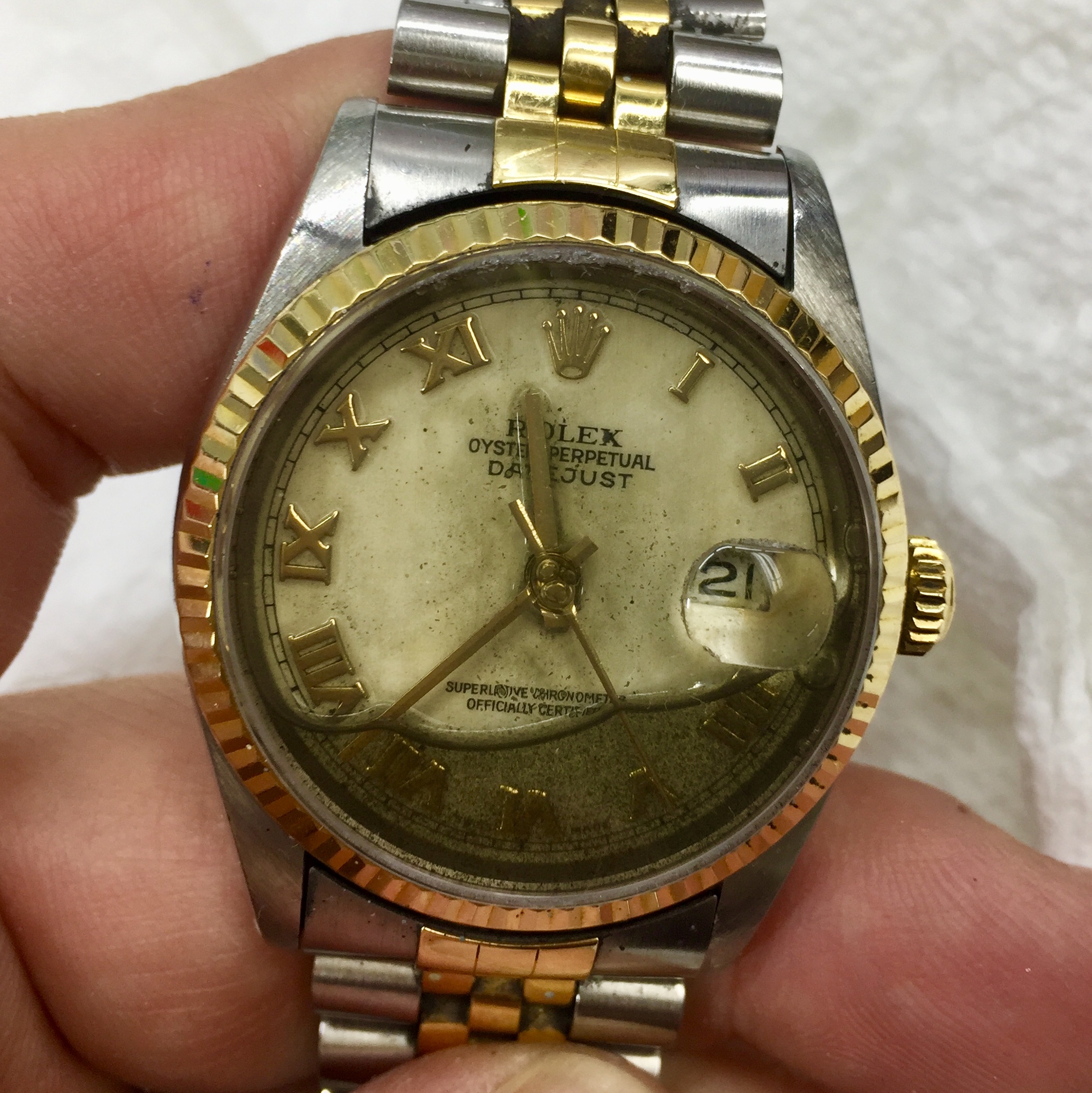
Rolex Doesn’t Work – Troubleshooting Guide
There are many potential reasons why your Rolex watch isn’t functioning the way it should. Some of them are easily solved and do not necessarily mean that your watch is broken. Other issues may be because your Rolex has broken and needs to be repaired.
In this article, we’re looking closer at the different issues with a Rolex watch that may cause it to not function properly and the troubleshooting for identifying these issues and finding a solution.
Rolex watches are known to be durable, robust, and long-lasting timepieces that can continue to tick year after year with little to no maintenance. But like all mechanical machines, issues that affect their proper functioning may arise due to a number of different reasons, some more serious than others.
If you’re experiencing issues with your Rolex where it doesn’t function the way it should or not at all, you need to troubleshoot it in order to identify the issue and resolve it.
Let’s begin with the most common issues that are easily solved and which do not mean that your watch is broken.
Not enough energy
This is the most common reason that your Rolex watch will stop and not work. It is also the easiest to resolve. The reason why some people will believe that their watch is broken when this happens is that they don’t completely understand how a Rolex functions and how it is powered.
Today, Rolex only manufactures automatic watches. In its early days, Rolex also made manual-wound watches and a few quartz watches, but the vast majority are automatic.
This means that they are powered by mechanical movements that are charged via a rotor that rotates by the movements from the wrist. But if you don’t wear your watch for some time, the watch will eventually run out of energy because it is not being wound by the rotor. Rolex watches generally have a power reserve of 48 to 72 hours. Some have less, others have more. This means that when you take it off, the watch will continue to tick for this amount of time, assuming it is fully wound. But when it finally runs out of energy, it stops.
If this happens, you need to manually wind the watch to charge it with energy again. To do this, unscrew the crown and wind it clockwise about 25 turns. This should get the watch to start ticking again.
Some people believe that they can ”shake” the watch to get it going, and in some cases, it may work. However, this is not advised. Whilst it may provide the watch with enough energy to start ticking, it will not be sufficient to fully charge it, meaning it may eventually stop again at a later stage.
Moreover, shaking it too violently may cause damage or unnecessary wear and tear to the movement.
If you tried this method and the watch started ticking again, there are no issues with your watch. It simply didn’t have any energy to function.
Worth mentioning is that the energy in your watch may also affect its accuracy. This is why it is a good idea to keep the watch fully wound, or almost fully wound, at all times.

Crown pulled out all the way (hacking seconds)
Another thing that may cause your watch to not work is if you have your crown pulled all the way out. Fortunately, this is an easy fix that is easily resolved.
Most Rolex watches have a so-called hacking seconds function. This means that when you pull the crown all the way out, it stops. The purpose of this is to allow for more accurate time-setting.
If you have the crown pulled all the way out, push the crown back to the first position and see if it starts. If it doesn’t start, try winding it according to the guidelines above and see if it is the lack of energy that is causing the issue.
Magnetized
Magnetism and mechanical movements do not go together very well. Mechanical movements consist of hundreds of small and delicate parts and may be affected by strong magnetic fields. If your watch is subject to magnetism, it may start acting strange and lose accuracy considerably. If it’s subject to strong magnetic fields, the watch may even stop.
Fortunately, resolving a magnetized watch is a relatively easy fix. Watchmakers have the proper machine to demagnetize the watch and this only takes a few minutes. You can even buy a watch demagnetizer yourself as these are small and affordable.

Rolex stopped working
If your Rolex watch has stopped working and you have tried all the methods above, you may be looking at an issue with the watch’s movement which requires service and repair. Whilst Rolex watches are robust and long-lasting machines, they occasionally need servicing to function properly, similar to the engine of a car. Worn-out parts need to be replaced and parts with a lot of friction and movement need to get new and fresh lubricants.
If your watch has been subject to some kind of trauma and stopped working after that, you can be fairly sure that something has broken and needs to be repaired. To ensure the proper functioning of the watch, the faulty part is usually not exclusively changed. Almost always, the movement gets a complete service at the same time to ensure that all components work together perfectly.
Some of the most common traumas that may cause a Rolex watch to break and stop working include:
- Dropping the watch
- The watch starts leaking water, for example, due to not screwing down the crown
- The watch was subject to shocks and bangs
- The watch is old and components have worn out or the lubricants have dried out
The latter does not necessarily mean that the watch is broken, but Rolex advises that a Rolex watch is serviced every 10 years. Things like lubricants will dry out and parts that are subject to friction may need to be replaced. Remember that a Rolex watch is powered by a mechanical movement consisting of hundreds of parts, so it is only natural that it needs to be maintained occasionally.
Identifying which of these are causing issues to your watch may or may not be difficult to do on your own, but it is still always advised that you take it to a professional watchmaker so that they can assess the watch and identify what is causing the issue. Oftentimes, the reason is not that something has clearly broken. It’s just that the watch hasn’t been serviced for a long time.
Regardless of the issue, the solution is usually always the same, a watch service. But depending on the condition of your movement, the service cost may be higher or lower depending on which parts, and how many parts, need to be replaced.

Moreover, just because you haven’t serviced the watch for a long time doesn’t necessarily mean that it will stop altogether. Usually, it will just make the watch lose its accuracy. This can be solved by service and calibration of the movement. Even if you haven’t used the watch for many years or even decades, it may require a service to get going.
When a Rolex sits unused for many years, the lubricants inside the movement will run dry. In addition, it is advised that you service your watch on a regular basis and not just when it loses accuracy or stops functioning. This is because if you continue to use the watch when the lubricants are dry, it will cause more wear and tear to the moving parts, which may lead to a more expensive service further down the road.
Broken internal parts
As mentioned, it can be difficult to identify whether a certain component inside the watch has broken which causes the watch to stop. Since you can’t resolve this issue by yourself, it’s best to turn to an experienced watchmaker. But if you can hear something rattling inside when you shake the watch, you are likely looking at a part that is loose inside and is causing issues with the watch’s proper functioning.
Since this is a complicated issue that needs to be solved by a professional watchmaker, it’s best to take the watch to one and get help to repair it. There’s not much else you can do if you have an internal problem with the watch.

Rust
Whilst Rolex uses its patented Oyster case construction for most of its watches to ensure exceptional water resistance, a watch can never be water-proof. The seals, or gaskets, are critical components of a watch to ensure proper water resistance, and over time, they may fail. Since gaskets are made of rubber, they will eventually dry out and need to be replaced. Therefore, if you don’t replace the gaskets occasionally, the water resistance may be compromised. The general recommendation is that you pressure-test the watch once a year if you plan to go swimming and diving with it for peace of mind.
All Rolex Oysters have a water resistance of at least 100m/330 feet.

At the same time, one of the most common reasons why Rolex watches leak is that the owner has forgotten to screw down the crown. Therefore, always make sure to screw down the crown before you jump into the water with your Rolex.
Water is one of the greatest enemies of a mechanical watch as it will cause rust and corrosion if it finds its way to the movement. Therefore, if you identify moisture on the inside of the crystal or even water inside the watch, you need to get it resolved as quickly as possible. The more time passes, the worse the damages will be, and the more expensive the repair will become due to the need of replacing more damaged parts.
To save yourself from the costs of repairing a water-damaged Rolex watch and to prevent the watch from leaking, have your watch pressure-tested once a year if you plan to go swimming or diving.





I have a new Sub M and the glow in the dark function works but not very well.
Hi,
Perhaps you have a Submariner with tritium luminescence? Or, it may just be poorly charged with energy.
Kind regards,
Millenary Watches
Had new battery installed 3 weeks ago on date adjust Rolex watch. Watch has stoped. Any idea what mite be wrong
Hi,
That sounds strange. If the battery only lasts for 3 weeks in an Oysterquartz, there is some kind of issue with the watch. You should visit a watchmaker and they will be able to identify what the issue may be.
Kind regards,
Millenary Watches
My 10 year old Rolex has totally stopped working. I always wear it. It has not been wet or damaged to my knowledge.
Is it worth an expensive fix or repair?
Hi!
Yes, absolutely!
If your watch is only 10 years old, the value of the watch is most likely higher than the cost of repair. For a regular service, the cost should be somewhere around $600-$800 depending on the condition and whether there are any major issues. Few 10-year-old Rolex watches are worth less than 2000 dollars but it’s hard to give an exact valuation without knowing the exact model and specifications.
Kind regards,
Millenary Watches
My watch was overhauls and now stops working about every 5 days. It is a perpetual watch that ran perfect for 20 years. I had it serviced but it stops about every 5 days. My service says it’s because I’m not using my arms as much as I am a senior. For 20 years it always ran without winding what’s it problem
Hi!
If you have a perpetual watch, it means that it is automatic and therefore wound by the rotor which rotates from the movement of the wrist. In general, older Rolex watches have a power reserve of about 48 hours when fully wound. This means that they can be left, for example, on a table and it will continue to tick for 48 hours.
With that said, an automatic watch needs movement to continue to be wound and continue to function. Therefore, if you don’t use your arms a lot, it may cause it to not be wound enough to continue ticking. This is not a completely uncommon issue we hear about from time to time when it comes to seniors and other people who may not move a lot.
That said, if you are not moving your arms sufficiently, our advise is to wind the watch manually via the crown every other day or so. To do this, you put the crown in the first position (screwing out the crown if it is a screw-down crown) and then wind it clockwise about 10-30 turns. This will provide the watch with energy to ensure it keeps ticking.
Hope this helps!
Kind regards,
Millenary Watches